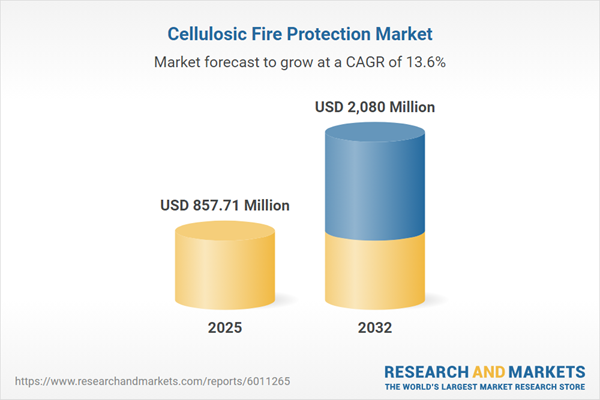Speak directly to the analyst to clarify any post sales queries you may have.
The cellulosic fire protection market is evolving rapidly, driven by tightening regulations, ongoing material innovation, and growing demand for resilient infrastructure. Leaders in construction, industrial, and transportation sectors increasingly seek advanced fire safety solutions matched to modern sustainability and operational standards.
Cellulosic Fire Protection Market Snapshot
The cellulosic fire protection sector grew from USD 754.12 million in 2024 to USD 857.71 million in 2025 and is projected to reach USD 2.08 billion by 2032, propelled by a compound annual growth rate (CAGR) of 13.57%.
Stakeholders are leveraging this expansion as the adoption of innovative coatings accelerates across key end-use industries, supported by heightened safety requirements and shifting preferences toward eco-friendly formulations.Scope & Segmentation: Product, Application, and Regional Landscape
- Product Type: Cementitious coatings (gypsum based, portland cement based, vermiculite based), epoxy coatings (novolac epoxy, phenolic epoxy, two-part epoxy), and intumescent coatings (ammonium polyphosphate based, epoxy resin based, graphite based).
- End-Use Industry: Aerospace and defense, automotive, building construction (commercial, industrial, residential), electrical and electronics, industrial machinery, marine, and oil and gas (downstream, midstream, upstream).
- Application Type: New installation, retrofit, and maintenance.
- Coating Method: Brush, roll, spray.
- Distribution Channel: Direct sales (OEM contracts, project sales), distributors & dealers (local dealers, national distributors), and online retail (e-commerce platforms, official brand websites).
- Regional Coverage: Americas (North America – United States, Canada, Mexico; Latin America – Brazil, Argentina, Chile, Colombia, Peru), Europe, Middle East & Africa (UK, Germany, France, Russia, Italy, Spain, Netherlands, Sweden, Poland, Switzerland, UAE, Saudi Arabia, Qatar, Turkey, Israel, South Africa, Nigeria, Egypt, Kenya), and Asia-Pacific (China, India, Japan, Australia, South Korea, Indonesia, Thailand, Malaysia, Singapore, Taiwan).
- Key Companies Covered: The Sherwin-Williams Company, PPG Industries, Akzo Nobel, RPM International, Jotun, Hempel, BASF, Kansai Paint, Axalta Coating Systems, Nippon Paint Holdings.
Key Takeaways for Decision-Makers
- Emerging binder and additive chemistries are enabling coatings tailored to specific fire safety requirements and end-user environments.
- Collaborative innovation among producers, equipment suppliers, and certification bodies is shaping product adoption and accelerating time-to-market for new technologies.
- Eco-friendly cellulosic coatings are rising in preference among customers seeking lower emissions and sustainable construction practices.
- Segmented application methods and diverse distribution channels are influencing accessibility and project cost efficiency at global and regional levels.
- Localized production strategies and vertical integration are helping manufacturers address supply chain volatility and regulatory changes.
- Growth opportunities are being driven by both retrofitting needs and large-scale new construction projects in sectors where regulatory compliance is paramount.
Impact of 2025 United States Tariff Adjustments
- Tariffs on cellulose derivatives and specialty binders have led manufacturers to reconsider raw material sourcing and invest in domestic processing facilities.
- Stakeholders are using long-term supply agreements and vertical integration to manage the effects of changing input costs, fostering stronger supply chain resilience.
- There is increased interest in alternative cellulose feedstocks, especially agricultural byproducts and recycled sources that reduce dependency on imported materials.
Methodology & Data Sources
This market analysis integrates primary research, including expert interviews, and secondary sources such as industry publications, regulatory filings, and technical papers. Quantitative and qualitative data were reconciled using data triangulation and subject matter workshops to validate segmentation and forecast trends.
Why This Report Matters for Senior Decision-Makers
- Gain a comprehensive view of evolving technology, regulatory shifts, and new supply chain dynamics shaping the cellulosic fire protection sector.
- Identify tailored innovation and partnership strategies that address both current fire safety mandates and future sustainability targets across global regions.
- Leverage segmentation insights to align product development and sourcing with the highest opportunity segments and mitigate emerging risks.
Conclusion
The cellulosic fire protection market is defined by innovation in materials, resilience to external pressures, and a shift toward sustainable, high-performance solutions. Senior leaders equipped with focused insights will be best positioned to drive growth and anticipate evolving industry demands.
Additional Product Information:
- Purchase of this report includes 1 year online access with quarterly updates.
- This report can be updated on request. Please contact our Customer Experience team using the Ask a Question widget on our website.
Table of Contents
3. Executive Summary
4. Market Overview
7. Cumulative Impact of Artificial Intelligence 2025
Companies Mentioned
The companies profiled in this Cellulosic Fire Protection market report include:- The Sherwin-Williams Company
- PPG Industries, Inc.
- Akzo Nobel N.V.
- RPM International Inc.
- Jotun A/S
- Hempel A/S
- BASF SE
- Kansai Paint Co., Ltd.
- Axalta Coating Systems Ltd.
- Nippon Paint Holdings Co., Ltd.
Table Information
| Report Attribute | Details |
|---|---|
| No. of Pages | 194 |
| Published | October 2025 |
| Forecast Period | 2025 - 2032 |
| Estimated Market Value ( USD | $ 857.71 Million |
| Forecasted Market Value ( USD | $ 2080 Million |
| Compound Annual Growth Rate | 13.5% |
| Regions Covered | Global |
| No. of Companies Mentioned | 11 |









